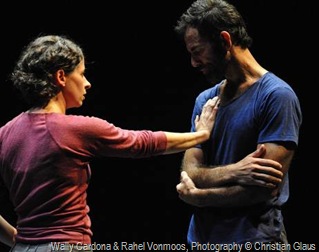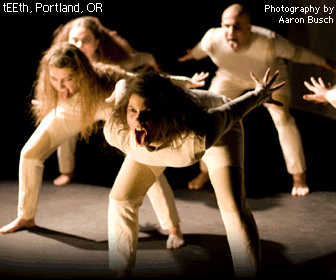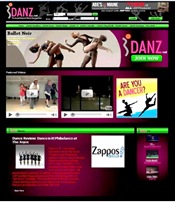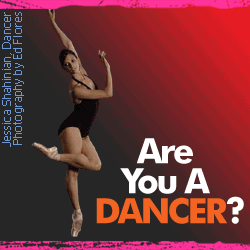Dance Review: "A Light Conversation" with Wally Cardona & Rahel Vonmoos
January 12, 2010 by iDANZ Today
Filed under iDANZ Critix Corner -Dance Reviews, iDANZ Features, Performance Art - Dance, Reviews
 Presenting at the Joyce SoHo, in A Light Conversation, Wally Cardona and Rahel Vonmoos skillfully address the complexity of relationships and the human condition by embracing ambiguity and crafting a landscape in which each viewer can follow their own path.
Presenting at the Joyce SoHo, in A Light Conversation, Wally Cardona and Rahel Vonmoos skillfully address the complexity of relationships and the human condition by embracing ambiguity and crafting a landscape in which each viewer can follow their own path.
The majority of the dance, choreographed and performed by Cardona and Vonmoos, is not performed with music, but instead, accompanied by a recording of a BBC radio show “In Our Time with Melvyn Bragg.” In this particular airing, Bragg and featured guests discuss the life and work of the philosopher Soren Kierkegaard and Socrates’ strong influence on his thought.
In this, Cardona and Vonmoos choose perhaps the heaviest of topics, and they approach it head-on and with humility. Instead of attempting to offer an explanation of Kierkegaard’s ideas through movement, Cardona and Vonmoos present themselves as two people making an honest investigation of his work. As the voices converse about the prolific philosopher, the dancers work through the subject, while the audience processes both the philosophical and the visual material. There are simultaneous conversations and interplays between the senses, the abstract, and the intellectual.
As the dance begins, the radio show plays straight through for several minutes before becoming altered and edited. In a wonderfully understated play on the subject at hand, a section of the dialogue that discusses Kierkegaard’s finding “reason in repetition” is repeated, giving the audience an opportunity to process the concept while each time watching a different set of movements.
 As with all conversations, in A Light Conversation there are multiple perspectives and perceptions. The audience’s attention vacillates between what they hear (Bragg’s interview with his scholarly guests), and what they see (the dancing on stage). Cardona and Vonmoos craft a delicate balance of sight and sound that is constantly shifted throughout the piece.
As with all conversations, in A Light Conversation there are multiple perspectives and perceptions. The audience’s attention vacillates between what they hear (Bragg’s interview with his scholarly guests), and what they see (the dancing on stage). Cardona and Vonmoos craft a delicate balance of sight and sound that is constantly shifted throughout the piece.
The movement vocabulary in A Light Conversation includes intimate and seamless partnering, simple gestures that resonate loudly with meaning (such as a repeated image of Cardona cradling Vonmoos while resting a heavy fist on her chest), and bold steps that travel sweepingly across the stage. At times, Cardona stands still while Vonmoos twists her torso and slices through the air with quick precision. Alternately, Cardona gestures and fluidly moves to and from the floor while Vonmoos carefully and slowly articulates her wrists and rearranges her position. Through these interplays of stillness and rapid movement, both dancers are never frozen; they stand quietly, sometimes posing, but always very much present, and aware of their surroundings. In the Joyce SoHo’s intimate theater space, Cardona and Vonmoos take the opportunity to occasionally make eye-contact with members of the audience, as if turning the questions to the viewer and involving them in the philosophical inquiries. With the audience seated on three sides of the stage, A Light Conversation breaks the fourth wall without drawing attention to the action of doing so.
This is perhaps the most satisfying and intriguing aspect of A Light Conversation: Cordona and Vonmoos’ treatment of the audience as part of this dialogue. They revel in the audiences’ shifting focus, in their inability to distinguish if the philosophical discussion is informing the movement, or if the movement is illustrating the discussion. As usual, the audience seeks a narrative, and A Light Conversation acknowledges this desire without placating it. Sometimes moments match up so perfectly—a discussion of a unified philosophical viewpoint coinciding with Cardona reaching out his hand to connect to Vonmoos’ shoulder comes to mind—and at other times, there is such a rhythmic and thematic disconnect between the words and the dance, that it is clear that things in philosophy, and life, are not so clear cut.
At one point, the recorded discussion refers to Socrates’ belief that there is no one true viewpoint from which the world can be viewed. Roderick Murray, who designed the lighting for this piece and for a number of Cardona’s past works, underscores this idea by lighting the theater in wide variety of arrangements throughout the duration of the work. The stage goes from a dim, almost dusk-like state, to being illuminated by blinding bright lights, to a point where the walls behind the audience are lit and the stage itself is neglected. These different arrangements make us aware that our perceptions of the stage, the audience, the performers, and the fourth wall, are relative.
As with all great conversation, A Light Conversation makes one ponder long after the event has ended. These age-old questions, even illuminated in this new light, continue to elude us and to exist in a state too dark to define.
 iDANZ Critix Corner
iDANZ Critix Corner
Official Dance Review by Tze Chun
Performance: “A Light Conversation” with Wally Cardona and Rahel Vonmoos
Venue: Joyce SoHo
Show Date: January 8, 2010
www.iDANZ.com
Have You Seen the iDANZ Social Network?
Click Here To Become a Member
of iDANZ.com Today!
The More Members We Have, The More We Can
Make a Difference.
It’s Free!
iDANZ – The Social Network Where Dancers Live! 








